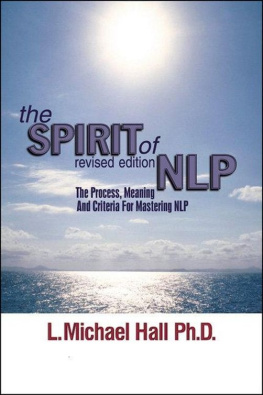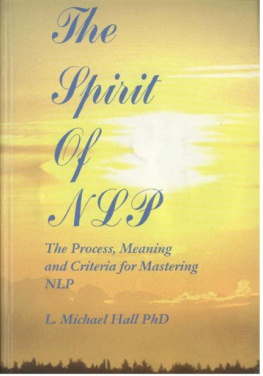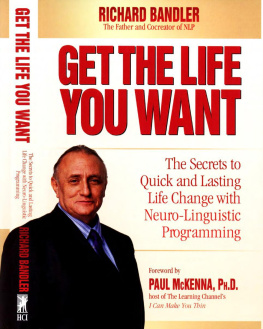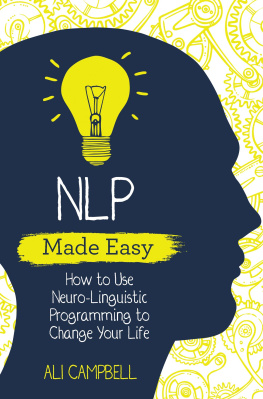Annotation
The meaning that any event has depends upon the frame in which we perceive it. When we change the frame, we change the meaning. Having two wild horses is a good thing until it is seen in the context of the son's broken leg. The broken leg seems to be bad in the context of peaceful village life; but in the context of conscription and war, it suddenly becomes good.
This is called reframing: changing the frame in which a person perceives events in order to change the meaning. When the meaning changes, the person's responses and behaviors also change.
Reframing. NeuroLinguistic Programming and
the Transformation of Meaning
Introduction
A very old Chinese Taoist story describes a farmer in a poor country village. He was considered very welltodo, because he owned a horse which he used for plowing and for transportation. One day his horse ran away. All his neighbors exclaimed how terrible this was, but the farmer simply said Maybe.
A few days later the horse returned and brought two wild horses with it. The neighbors all rejoiced at his good fortune, but the farmer just said Maybe.
The next day the farmer's son tried to ride one of the wild horses; the horse threw him and broke his leg. The neighbors all offered their sympathy for his misfortune, but the farmer again said Maybe.
The next week conscription officers came to the village to take young men for the army. They rejected the farmer's son because of his broken leg. When the neighbors told him how lucky he was, the farmer replied Maybe.
The meaning that any event has depends upon the frame in which we perceive it. When we change the frame, we change the meaning. Having two wild horses is a good thing until it is seen in the context of the son's broken leg. The broken leg seems to be bad in the context of peaceful village life; but in the context of conscription and war, it suddenly becomes good.
This is called reframing: changing the frame in which a person perceives events in order to change the meaning. When the meaning changes, the person's responses and behaviors also change.
Reframing is not new. Many fables and fairy tales include behaviors or events that change their meaning when the frames around them change. The differentlooking chick seems to be an ugly duckling, but he turns out to be a swanmore beautiful than the ducks he has been comparing himself to. Reindeer Rudolfs funnylooking red nose becomes useful for guiding Santa's sleigh on a foggy night.
Reframing also appears in almost every joke. What seems to be one thing, suddenly shifts and becomes something else.
1) What's green all over and has wheels?
2) What do Alexander the Great and Smokey the Bear have in common?
(Answers appear at the end of this introduction.)
Reframing is also the pivotal element in the creative process: it is the ability to put a commonplace event in a new frame that is useful or enjoyable. A friend of physicist Donald Glaser pointed to a glass of beer and jokingly said Why don't you use that to catch your subatomic particles? Glaser looked at the bubbles forming in the beer, and went back to his lab to invent the bubble chamber," similar to the Wilson cloud chamber, for detecting the paths of particles in highenergy physics experiments. Arthur Koestler, in The Act of Creation, calls this process bisociation: the ability to simultaneously associate an event in two very separate and different contexts.
In general communication theory there is a basic axiom that a signal only has meaning in terms of the frame or context in which it appears. The sound of a squeaky shoe on a busy sidewalk has little meaning; the same sound outside your window when you are alone in bed means something else altogether. A light in a church belfry is simply that. But to Paul Revere it meant that the British were coming, and also how they were coming: one if by land, and two if by sea. The light only has meaning in terms of the previous instructions that established a framean internal context that creates meaning.
Reframing appears widely in the therapeutic context. When a therapist tries to get a client to think about things differently or see a new point of view or to take other factors into consideration," these are attempts to reframe events in order to get the client to respond differently to them.
Explicit conceptualizations of reframing have been used by a number of therapists who understand that problem behavior only makes sense when it is viewed in the context in which it occurs. These include a number of therapists with a family or systems orientation, notably Paul Watzlawick and the Mental Research Institute group in Palo Alto, and Jay Haley and Salvador Minuchin and the group at the Philadelphia Child Guidance Clinic. These therapists generally use what is described in Chapter I as content reframing.
They have designed specific reframing interventions such as prescribing the symptom," and paradoxical injunction," which effectively reframe behavior in order to change it. They also use techniques of directly intervening to change the actual external physical context in which the behavior occurs.
Virginia Satir uses a great deal of reframing in her work, from simple redefinitions to more elaborate reframing via psychodrama in her parts parties and family reconstructions.
Carl Whitaker reframes with nearly everything he says to the families that he works with. Symptoms become reframed as accomplishments or skills, sanity becomes craziness, and craziness becomes sanity.
A more elaborate and allpurpose method of reframing, called sixstep reframing, was developed by Bandler and Grinder, and already appears in print in Frogs into Princes. This book presupposes that you are already familiar with that basic sixstep model of reframing; much of the book will make sense to you only if you have some prior knowledge of, and experience with, that kind of reframing. You can find an excellent description and discussion of sixstep reframing (as well as other basic NLP patterns) in the third chapter of Frogs into Princes.
What is new in this book is an explicit description of the basic structure of reframing, and the presentation of several additional models of reframing. This book presents specific stepbystep techniques to implement these models, as well as ways to determine which model is most appropriate for a particular problem situation.
This is a book about advanced reframing. The first three chapters present several distinct alternative models of reframing that are useful in certain contexts, and for specific kinds of problems. Following that are chapters about building flexibility in doing sixstep reframing (Chapter IV), reframing with couples, families, and other larger systems such as businesses (Chapter V), reframing with alcoholics and other examples of dissociated states (Chapter VI).
Reframing is a very powerful communication tool. This book takes it from the realm of a hitandmiss art to a set of predictable and systematic interventions for achieving behavioral change.
This book has been edited from transcriptions of a number of different workshops and training seminars presented by Bandler and Grinder, and is presented here as if it were a single threeday workshop. No distinction is made between when Richard is speaking and when
John is speaking, and the names of most participants have been changed.
As you read this book, keep in mind that Bandler and Grinder are usually doing what they're talking about. The astute reader will find much more in the text than is overtly commented upon.











